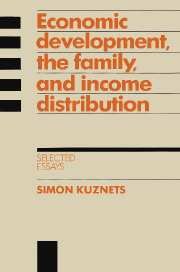Book contents
- Frontmatter
- Contents
- Preface by Louis Galambos and Robert Gallman
- Foreword by Richard A. Easterlin
- 1 Driving forces of economic growth: what can we learn from history?
- 2 A note on production structure and aggregate growth
- 3 The pattern of shift of labor force from agriculture, 1950–70
- 4 Modern economic growth and the less developed countries
- 5 Notes on demographic change
- 6 Recent population trends in less developed countries and implications for internal income inequality
- 7 Demographic aspects of the size distribution of income: an exploratory essay
- 8 Size and age structure of family households: exploratory comparisons
- 9 Size of households and income disparities
- 10 Distributions of households by size: differences and trends
- 11 Children and adults in the income distribution
- Afterword: Some notes on the scientific methods of Simon Kuznets by Robert William Fogel
- Bibliography of Simon Kuznets
- Index
4 - Modern economic growth and the less developed countries
Published online by Cambridge University Press: 12 November 2009
- Frontmatter
- Contents
- Preface by Louis Galambos and Robert Gallman
- Foreword by Richard A. Easterlin
- 1 Driving forces of economic growth: what can we learn from history?
- 2 A note on production structure and aggregate growth
- 3 The pattern of shift of labor force from agriculture, 1950–70
- 4 Modern economic growth and the less developed countries
- 5 Notes on demographic change
- 6 Recent population trends in less developed countries and implications for internal income inequality
- 7 Demographic aspects of the size distribution of income: an exploratory essay
- 8 Size and age structure of family households: exploratory comparisons
- 9 Size of households and income disparities
- 10 Distributions of households by size: differences and trends
- 11 Children and adults in the income distribution
- Afterword: Some notes on the scientific methods of Simon Kuznets by Robert William Fogel
- Bibliography of Simon Kuznets
- Index
Summary
In thinking of the impressive record of Taiwan's economic growth over the last three decades, to be documented and discussed in the papers for this Conference, I was tempted to reflect on the conditions that permit and induce such a performance in an LDC. One such condition is indicated by the existence of the more developed countries, with their demonstrated contribution of modern economic growth to the great increase in product per capita or per worker – for it indicates the existence of a technological backlog, the exploitation of which could generate accelerated advance elsewhere. The characteristics of modern economic growth are thus important in both helping us to identify the LDCs, and in enabling us to infer, if only tentatively, the kinds of breakthrough that can initiate and sustain a high rate of growth in an LDC – after a long period of stagnation or of moderate advance.
Distinctive characteristics of modern economic growth
The basic feature of modern economic growth, as it has been observed in the more developed countries since the late 18th century, is that the rise in per capita or per worker product was associated largely with extended application of a growing stock of useful knowledge, via technological innovations in production.
- Type
- Chapter
- Information
- Economic Development, the Family, and Income DistributionSelected Essays, pp. 68 - 77Publisher: Cambridge University PressPrint publication year: 1989
- 1
- Cited by



